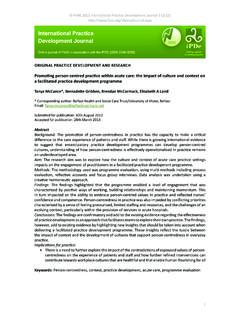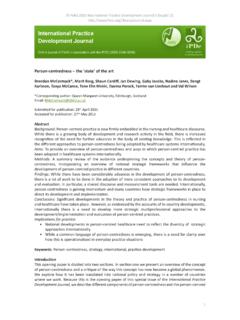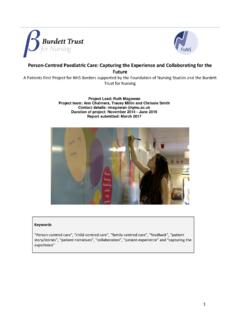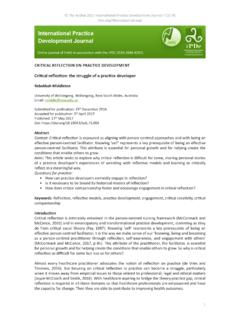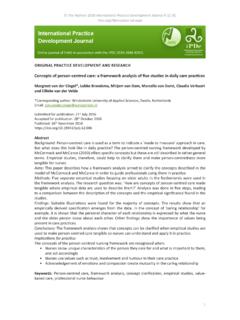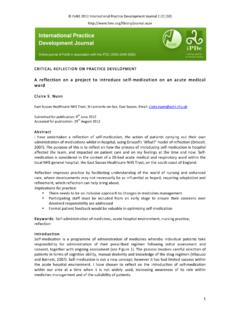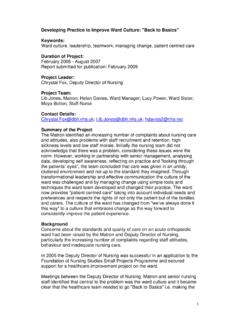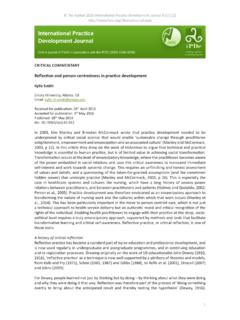Transcription of The importance of inspiring a shared vision - FoNS
1 FoNS 2014 International Practice Development Journal 4 (2) [4]. ORIGINAL PRACTICE DEVELOPMENT AND RESEARCH. The importance of inspiring a shared vision Jacqueline Martin*, Brendan McCormack, Donna Fitzsimons and Rebecca Spirig *Corresponding author: University Hospital Basel, Switzerland Submitted for publication: 25th June 2014. Accepted for publication: 3rd September 2014. Abstract Background: Leadership programmes have been used to support nurse leaders in developing their skills and equiping them as transformative change agents in healthcare organisations around the world. For this purpose, the Royal College of Nursing's Clinical Leadership Programme has been adapted, implemented, and evaluated in Switzerland. Although a shared vision is a key element in leading organisations and in change, the impact of such a vision on clinical practice is rarely described in the literature.
2 Aims and objectives: To determine qualitatively the benefits of a shared vision as one essential feature of leadership behaviour. Methods: In the context of a mixed methods research study, individual interviews with nurse leaders, as well as focus group interviews with their respective teams, were recorded and transcribed verbatim prior to qualitative content analysis. In order to integrate all findings, a triangulation protocol was applied after separate analysis. Findings: Having a vision helped leaders and their teams to become inspired and committed to a shared goal. Moreover, the vision was a strong driving force for ongoing and systematic practice development and thus established a culture that favoured quality and safety improvement in patient care. However, the strategic direction needed to be tempered; the positive impact on teams and their care practices generated a great deal of enthusiasm, which had the potential to overload the organisation through taking on more than could reasonably be accomplished.
3 Conclusion: The study found that a vision provides orientation and meaning for leaders and their teams. It helps them to focus their energies and engage in the transformation of practice. However, it is very important for leaders to monitor closely the energy level of teams and the organisation, in order to maintain the balance between innovation/transformation and relaxation/recovery. Implications for practice: A vision provides orientation and meaning for leaders and their teams and is a strong driving force for ongoing and systematic practice development The enthusiasm at the beginning brought about the danger of starting too many activities, thus overloading the organisation. Therefore, it is important for leaders to maintain the balance between innovation/transformation and relaxation/recovery Care should be taken to ensure that a vision and corresponding core values are realistic and achievable.
4 Otherwise, the vision might remain an unattainable illusion, and the individuals who are supposed to turn it into reality may become frustrated and demotivated Keywords: Leadership programme, nurses, vision , practice development, evaluation, triangulation 1. FoNS 2014 International Practice Development Journal 4 (2) [4]. Introduction Effective leadership is an essential attribute for the provision of professional and high quality healthcare, which refers to care that is person centred, evidence based and outcome oriented (Kramer et al., 2004;. Manojlovich, 2005a; 2005b; Alleyne and Jumaa, 2007). Effective leadership is also critical for improving the quality and safety of patient care while balancing the increased demands for cost effectiveness (Wong and Cummings, 2007; Watkins, 2010). One key element in effective leadership is inspiring a shared vision , which is a major element of change processes in terms of providing orientation and engaging the whole system towards excellence in healthcare practice (Lukas et al.)
5 , 2007; McCormack et al., 2007). However, to achieve effective leadership practices, there needs to be a shift from hierarchical approaches to leadership styles that encourage shared governance and facilitate staff empowerment (Williamson, 2005). With this kind of leadership approach, leaders are better able to convey the need for change, question existing practice, create a vision for the future and develop new models of service provision (Dixon, 1999; Porter-O'Grady, 2003). Transformational leadership is one such approach and has been shown to have a high impact in nursing on practice changes in care provision and on the development of an organisational culture that is receptive to progression and change (Shaw, 2005; Field and FitzGerald, 2006). The development of transformational leadership skills among nurse leaders is important for healthcare organisations seeking to achieve high quality care (Trofino, 2000; Donaldson, 2001; Cook and Leathard, 2004; Davidson et al.
6 , 2006; Watkins, 2010) and an effective workplace culture (Manley et al., 2011). Therefore, a Clinical Leadership Programme for nurse leaders was set up in 1995. by the Royal College of Nursing (RCN) and then delivered internationally (Cunningham and Kitson, 2000). The need for enhanced leadership skills is also evident in the Swiss healthcare context (De Geest et al., 2003) and in 2006, the RCN's programme was adapted and implemented in the German speaking part of Switzerland for nurse leaders. One of the adaptations was an explicit focus on the development of a unit based vision , since to inspire a shared vision ' is one of the main competencies of transformational leaders (Kouzes and Posner, 2007; 2010). Previous research asserts that a vision is an extremely powerful tool for driving an organisation toward excellence, and developing a clear vision is the best way to clarify the direction of change (Hoyle, 2007).
7 Moreover, the aim of a vision is to display a picture of a better and more worthwhile future state, which, in healthcare, means an improvement in service delivery. Therefore, participating ward leaders were challenged to develop a shared vision for their unit, as well as corresponding goals and actions, and thus to focus available resources on targeted and evidence based developments in practice. It should be noted that German speaking nurses and nurse leaders seldom use the word vision ', preferring terms such as strategy' and strategic direction'. Although there is a shared understanding in the literature of how important and critical a vision is for outstanding leadership and effective change in organisations (Viens et al., 2005; Felgen, 2007), little is known about the experience of nurse leaders and their teams in developing a vision , or about the impact of a vision on their work and on practice development.
8 Greater knowledge and understanding in this regard may help healthcare leaders to focus energy in this area and secure the resources required to achieve the targeted transformation in practice. This paper reports on findings from the second, qualitative phase of a mixed methods research study whose overall purpose was to evaluate the impact of the Clinical Leadership Programme in Switzerland. The study was organised in two distinct sequential phases. The first, quantitative phase focused on the evaluation of leadership competencies of programme participants; the second, qualitative phase focused on explanation and validation of the quantitative results obtained in the first phase by exploring participants' views in greater depth. One particular goal of the qualitative phase was to determine the benefits of a shared vision and corresponding strategies for leaders and their teams, as one essential practice of leadership behaviour 2.
9 FoNS 2014 International Practice Development Journal 4 (2) [4]. (Kouzes and Posner, 2007). Therefore individual interviews with nurse leaders, as well as focus group interviews with their respective teams, were conducted. In order to integrate the findings of all in- depth interviews, a triangulation protocol was applied. This article reports on the triangulated results from the qualitative follow-up to address the research question: What was the influence of a vision or strategic direction on practice/practice development? Theoretical framework This study was underpinned by two theoretical perspectives. First, the theory of learned leader behaviours of Kouzes and Posner (2007), a transformational leadership theory that postulates that leadership behaviour can be observed and learned. Research within the field has documented a consistent pattern in the characteristics of admired leaders across countries, cultures, organisations, hierarchies, gender, education, and age groups (Kouzes and Posner, 2007).
10 The five fundamental practices of exemplary leadership have been defined as: 1. Modelling the way 2. inspiring a shared vision 3. Challenging the process 4. Enabling others to act 5. Encouraging the heart The second theoretical perspective was the conceptual framework of practice development by Garbett and McCormack (2004), who define practice development as a systematic and ongoing process towards effective and person-centred care. Practice development facilitators initiate and support an emancipatory process of change that reflects the perspectives of patients and healthcare providers (Garbett and McCormack, 2002; Sanders et al., 2013). This emancipatory approach aims to empower and enable healthcare teams to transform the culture and context of care in a way that will result in sustainable change (McCormack and Titchen, 2006; Shaw, 2013).
